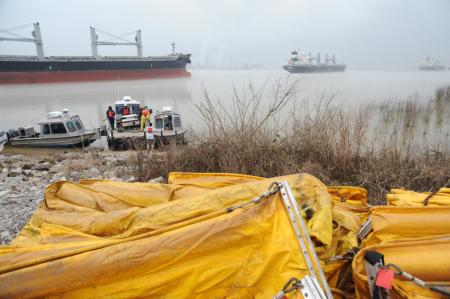As of Feb. 25, about 150 federal, state, local, and industry responders remained on the scene of a collision between tows, one of which was pushing tank barges, in the Mississippi River, a short distance from New Orleans.
A Joint Information Center (JIC) is up and operating and has reported that lightering operations removed 1,021 gals. of oily/water mix from the river. Officials had earlier calculated that approximately 31,500 gals. of light crude oil was discharged. ES&H of Laplace, La., is handling clean-up duties for the operation. The light sheen on the river's surface is quickly dissipating, a Coast Guard spokesperson said. The Center has released no information about the direction of the tows when the accident occurred. The river is currently open to traffic in both directions.
Saturday, Coast Guard Sector New Orleans watchstanders received a report from the National Response Center at approximately 3:30 p.m. that a vessel collided with a tank barge as it transited along the river near Vacherie, La. The barge, one of two loaded with light crude and being pushed by the 2,600 hp Hannah C. Settoon, hit the Lindsay Ann Erickson, which was pushing grain barges, the AP reports.
The 6,800 hp, 168'x40' Lindsay Ann Erickson, operated by Marquette Transportation, was built in 1982. The 88'x35'x9' Hannah C. Settoon, operated by Pierre Part, La-based Settoon Towing, was built in 2010.
The collision damaged the barge which caused a release of light crude oil into the Mississippi River. There were no injuries as a result of the collision.
Lightering operations on the damaged barge concluded early Sunday morning and the source of the spill was secured. Oil spill response vessels and recovery equipment are deployed in the river.
The Coast Guard Captain of the Port closed the river from mile marker 90 to mile maker 155 to avoid possible contamination of passing vessels and to reduce the amount of oil spreading farther down the river.
The Coast Guard reopened the portion of the Mississippi River that falls within the Port of New Orleans’ jurisdiction on Monday at 10 a.m. with the condition that vessels self-certify that their hulls are clean. At 1:30 p.m. on Monday, the U.S. Coast Guard reopened with restrictions all portions of the Mississippi River to all traffic.
The Unified Command continues response operations in connection with the incident. Response crews with Environmental Safety & Health, an oil spill removal organization, have strategically deployed containment boom to protect the water intakes for three parishes in the affected area. All impacted water intake facilities in the affected area are taking precautionary measures to prevent contamination.
The Unified Command has confirmed with local officials that there are no impacts to drinking water.
The Center for Toxicology and Environmental Health is conducting air monitoring for air pollution threats. No exposure concerns to the public have been detected through this monitoring.
While the river was closed, 10 ships were delayed at the port, five awaiting departure at port docks and five directed to anchorages downriver awaiting entry to the Port. Coast Guard officials allowed two cruise ships at the Port’s cruise terminals Feb. 23 to sail as scheduled.
“As always safety and the environment are our top priorities,” said Gary LaGrange, Port of New Orleans president and CEO. “We work closely with the Coast Guard and entire maritime community to ensure commerce moves as soon as it is safe to do so.”





